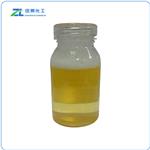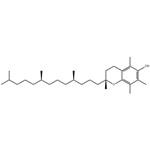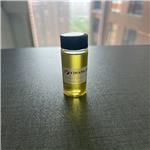- Vitamin E
-

- $10.00 / 1kg
-
2024-04-23
- CAS:59-02-9
- Min. Order: 1kg
- Purity: 99%
- Supply Ability: 50000KG/month
- Vitamin E
-

- $50.00 / 1KG
-
2023-12-23
- CAS:59-02-9
- Min. Order: 1KG
- Purity: 99%
- Supply Ability: g-kg-tons, free sample is available
- Vitamin E
-

- $0.00 / 1kg
-
2023-11-29
- CAS:59-02-9
- Min. Order: 1kg
- Purity: 99%
- Supply Ability: 50000kg
|
| | Vitamin E Basic information |
| | Vitamin E Chemical Properties |
| Melting point | 2.5-3.5 °C | | Boiling point | 200-220 °C0.1 mm Hg(lit.) | | alpha | 24 º (c=2, in isooctane 25 ºC) | | density | 0.95 g/mL at 25 °C(lit.) | | refractive index | n20/D 1.505(lit.) | | Fp | 253 °C | | storage temp. | -20°C | | solubility | Practically insoluble in water, freely soluble in acetone, in anhydrous ethanol, in methylene chloride and in fatty oils. | | pka | 11.40±0.40(Predicted) | | form | oil | | color | clear yellow | | Odor | lt. yel. to red visc. oil, nearly odorless | | Water Solubility | INSOLUBLE | | Merck | 14,9495 | | BRN | 4712525 | | Stability: | Stable. Combustible. May be sensitive to light and air. Incompatible with strong oxidizing agents. | | LogP | 10.962 (est) | | CAS DataBase Reference | 59-02-9(CAS DataBase Reference) | | NIST Chemistry Reference | Vitamin e(59-02-9) | | EPA Substance Registry System | 2H-1-Benzopyran-6-ol, 3,4-dihydro-2,5,7,8-tetramethyl-2-[(4R,8R)-4,8,12-trimethyltridecyl]-, (2R)- (59-02-9) |
| | Vitamin E Usage And Synthesis |
| Chemical Properties | light yellow liquid | | Chemical Properties | VITAMIN E is sometimes referred to as the antisterility vitamin, factor X (an earlier designation), chemically vitamin E is alphatocopherol. Active analogues and related compounds include: dl-α-Tocopherol; 1-α-tocopherol; esters (succinate, acetate, phosphate), and β, ζ 1, ζ 2- tocopherols. The principal physiological forms are D-a-tocopherol, tocopheronolactone, and their phosphate esters. | | Originator | Doppelherz,Queisser Pharma,Germany | | Uses | vitamin E, antioxidant | | Uses | α-Tocopherol is the most bioactive of the naturally occurring forms of Vitamin E. Richest sources are green vegetables, grains, and oils, particularly palm, safflower and sunflower oils. | | Uses | Use in insect cell culture applications as an antioxidant. | | Definition | ChEBI: An alpha-tocopherol that has R,R,R configuration. The naturally occurring stereoisomer of alpha-tocopherol, it is found particularly in sunflower and olive oils. | | Manufacturing Process | Manufacturing process for Vitamin E, that is, α-tocopherol (5,7,8-trimethyltocol) in the
past has been accomplished primarily by reacting trimethylhydroquinone
(TMHQ) with isophytol (3,7,11,15-tetramethylhexadec-1-en-3-ol) or phytol
(3,7,11,15-tetramethylhexadec-2-en-1-ol) in a condensation reaction. The
reaction is well known and has been practiced for many years (Stalla�Bourdillon, Ind. Chim. Belg., 35, 13 (1970); "The Vitamins" Vol. 5, pages 168-
223, Academic Press, New York, 1967).
The Synthesis of Vitamin E includes these steps as follows: Rearrangement to C15 Acetylene; Saponification of the C20 Dienol Acetate to Dehydrophytol;Condensation of Dehydrophytol with TMHQ to yield Dehydro-Vitamin E. | | Therapeutic Function | Antioxidant | | General Description | α-Tocopherol is synthesized from γ-tocopherol by the action of enzyme γ-tocopherol methyltransferase. It is the major form of Vitamin E in human plasma. It is present in sunflower seed oil. | | Health Hazard | The physiological functions of vitamin E substances include: (1) bio logical antioxidant; (2) normal growth maintenance; (3) protects unsaturated fatty acids and membrane structures; (4) aids intestinal absorption of unsaturated fatty acids; (5) maintains normal muscle metabolism; (6) maintains integrity of vascular system and central nervous system; (7) detoxifying agent; and (8) maintains kidney tubules, lungs, genital structures, liver, and red blood cell membranes.
In livestock and laboratory animals, a deficiency of vitamin E substances may cause degeneration of reproductive tissues, muscular dystrophy, encephalomalacia, and liver necrosis. Considerable research is required to fully determine supplementation of livestock diets unless typical symptoms of a deficiency appear. Symptoms have appeared where there are selenium deficiencies in the soil and where there are excessive levels of nitrates in the soil. “White muscle” is the term used to describe a condition of muscular dystrophy in cattle. | | Biochem/physiol Actions | α-Tocopherol is essential for the photosynthesis in Synechocystis sp. strain PCC 6803. Supplementation with α-Tocopherol decreases lipid peroxidation and platelet aggregation. It inhibits protein kinase C and may play key role in gene regulation. | | Safety Profile | Experimental
reproductive effects. Mutation data
reported. When heated to decomposition it
emits acrid smoke and irritating fumes. | | Purification Methods | Vitamin E is a viscous yellow oil which is distilled at high vacuum. It has max at 294nm (E1cm 1% 71). It is oxygen and light sensitive and is best stored as its stable D--acetate [58-95-7] which is purified by evaporative distillation at b 180-200o(bath temperature)/0.7mm, and has [] D 25 +3.3o (c 5.1, EtOH). It forms needles at -30o and has m 26.5-27.5o, [] D 25 +0.25o (c 10, CHCl3). [NMR: Cohen et al. Helv Chim Acta 6 4 1158 1981, Burton & Ingold Acc Chem Res 1 9 194 1986, Karrer et al. Helv Chim Acta 2 1 520 1938, Robeson J Am Chem Soc, 64 1487 1942, 65 1660 1943.] Of the eight isomers the D--isomer is the most active. [See W. Friedrich “Vitamins” Walter de Guyter Publ, Berlin 1988.] [Beilstein 17/4 V 168.] |
| | Vitamin E Preparation Products And Raw materials |
| Raw materials | Acetic anhydride-->Isophytol-->Trimethylhydroquinone-->Methylmagnesium chloride-->Lithium-->Sodium amide-->6,10-dimethylundecan-2-one-->Isoprene-->Copper(I) chloride-->Palladium-->Ferric nitrate nonahydrate-->PALLADIUM ON STRONTIUM CARBONATE, REDUCED-->ZINC-->Luteolin-->acetate | | Preparation Products | Tocopheryl acetate-->1,4-Benzenediol, 2,3-dimethyl-5-[(2E,7R,11R)-3,7,11,15-tetramethyl-2-hexadecen-1-yl]--->D-gamma-Tocopherol-->Benzoic acid, 2,5-dihydroxy-, (2R)-3,4-dihydro-2,5,7,8-tetramethyl-2-[(4R,8R)-4,8,12-trimethyltridecyl]-2H-1-benzopyran-6-yl ester |
|